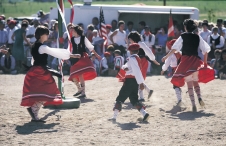Folk Genres
The "lore" of folklore can be divided into genres or the categories of expression that people learn and create as a part of their heritage. At the broadest level, genres can be categorized as oral, performance, material, or customary. Specifically, the list of folk genres is almost endless. Oral traditions include such things as stories, legends, jokes, and songs, but songs can also be grouped with performance traditions as can instrumental music and dances. Material traditions include crafts, costumes, foods, and vernacular (or traditional) architecture. Customary folklore includes occupational skills and celebrations.
In the real world, of course, these categories do not remain rigid and impermeable, and there is a great amount of overlap and mixing among them. For example, a song such as the Mexican birthday song, Las Maanitas, is often part of a larger celebration. In many Mexican-American communities, the birthday person is serenaded at dawn with this song. As another example, insider jokes and pranks are frequently a part of the lore of a particular occupation, and food traditions permeate every cultural group and are a part of many ethnic, family and community events and celebrations.
People do not categorize what they do in terms of genres, so in some sense genres are arbitrary constructs set up by researchers, but they can be useful in looking at the same form across cultures or across time or space. Some American cowboy songs can be traced back to England or Ireland. They were brought across the ocean with the early immigrants and then made their way West, with changes in lyrics to describe the new landscapes the settlers encountered and cultural practices they created. The same song may also have variations depending on the part of the country it comes from. As another example, a particular architectural form or style may have been built on a ranch by early settlers from Italy, but later adapted or modified to the climate and the techniques of ranching that developed to suit a new environment. Studying similarities and differences in a particular genre can also reveal modes of transmission, points of contact, and points of divergence.
Many genres can be broken down further into subgenres. For instance, crafts can be divided by material into textiles, leather, wood, metal, etc. Then the textile category can be further parsed into quilting, weaving, embroidery, knitting, and costumes, and the quilting category into pieced and appliqud, as well as piecing into various types of patterns.
As a general introductory overview, Online Nevada Encyclopedia entries focus on some of the larger categories of folk expression found specifically in Nevada, with more detail provided for those forms that are unique or particularly well-developed, such as Native American basketry and cowboy poetry.
Genres provide a useful way to subdivide the enormous range of folk forms into manageable bites. Even a single item like a song or a saddle or a soup can provide an entry point into the complexities and beauties of a culture and open up new worlds of understanding through the window of traditional culture.
Article Locations
Related Articles
Further Reading
None at this time.

